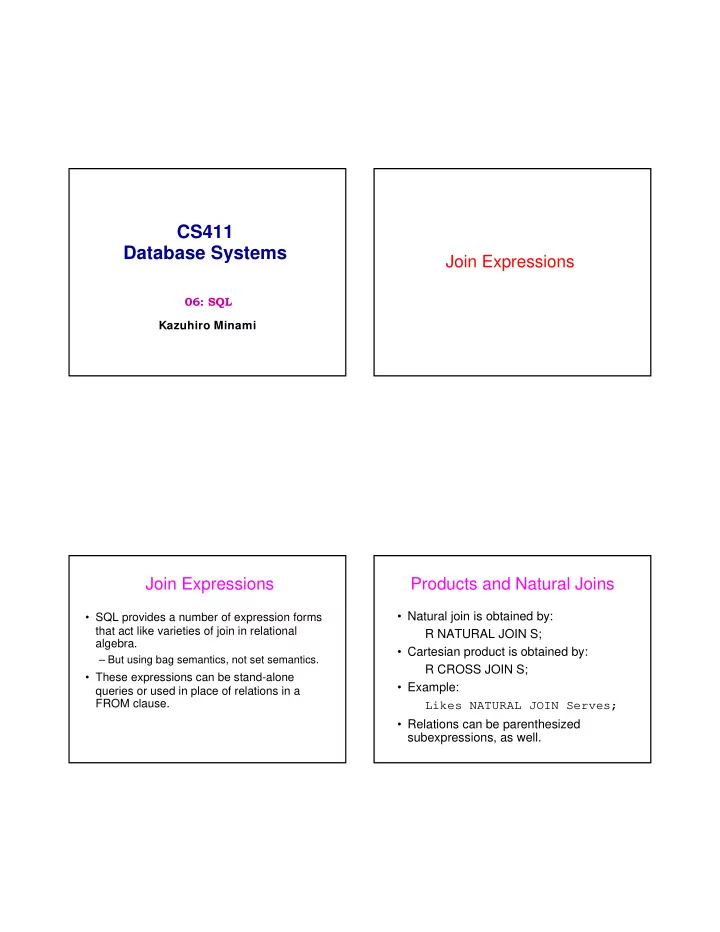

CS411 Database Systems Join Expressions 06: SQL Kazuhiro Minami Join Expressions Products and Natural Joins • Natural join is obtained by: • SQL provides a number of expression forms that act like varieties of join in relational R NATURAL JOIN S; algebra. • Cartesian product is obtained by: – But using bag semantics, not set semantics. R CROSS JOIN S; • These expressions can be stand-alone • Example: queries or used in place of relations in a FROM clause. Likes NATURAL JOIN Serves; • Relations can be parenthesized subexpressions, as well.
Theta Join • R JOIN S ON <condition> is a theta- join, using <condition> for selection. • Example: using Drinkers(name, addr) Grouping and Aggregation and Frequents(drinker, bar): Drinkers JOIN Frequents ON name = drinker; gives us all ( d, a, d, b ) quadruples such that drinker d lives at address a and frequents bar b . Aggregations Example: Aggregation From Sells(bar, beer, price), find the average price of Bud: • SUM, AVG, COUNT, MIN, and MAX can be applied to a column in a SELECT clause to produce that aggregation on the column. SELECT AVG(price) • Also, COUNT(*) counts the number of tuples. FROM Sells WHERE beer = ‘Bud’;
Eliminating Duplicates NULLs are ignored in in an Aggregation aggregations of a column SELECT count(*) • DISTINCT inside an aggregation causes The number of bars FROM Sells that sell Bud duplicates to be eliminated before the WHERE beer = ‘Bud’; aggregation. • Example: find the number of different The number of bars prices charged for Bud: SELECT count(price) that sell Bud at a FROM Sells non-null price SELECT COUNT( DISTINCT price) WHERE beer = ‘Bud’; FROM Sells WHERE beer = ‘Bud’; If there are no non-NULL values in a column, then the result of the aggregation is NULL Example: Grouping Grouping Sells(bar, beer, price) • We may follow a SELECT-FROM-WHERE expression by GROUP BY and a list of Q: find the average price for each beer: attributes. • The relation that results from the SELECT- SELECT beer, AVG(price) FROM-WHERE is partitioned according to FROM Sells the values of all those attributes, and any aggregation is applied only within each GROUP BY beer; group.
Example: Grouping Restriction on SELECT Lists With Aggregation Frequents(drinker, bar), Sells(bar, beer, price) Q: find for each drinker the average price of Bud at the bars they frequent: SELECT drinker, AVG(price) • If any aggregation is used, then each element Compute of the SELECT list must be either: FROM Frequents, Sells drinker-bar- price of Bud 1. Aggregated, or WHERE Sells.bar = Frequents.bar tuples first, 2. An attribute on the GROUP BY list. AND beer = ‘Bud’ then group by drinker. GROUP BY drinker; HAVING Clauses Illegal Query Example You might think you could find the bar that • HAVING <condition> may follow a GROUP sells Bud the cheapest by: BY clause. SELECT bar, MIN(price) FROM Sells • If so, the condition applies to each group, and WHERE beer = ‘Bud’; groups not satisfying the condition are eliminated. But this query is illegal in SQL. – Why? Note bar is neither aggregated nor on the GROUP BY list.
Requirements on HAVING Example: HAVING Conditions Sells(bar, beer, price) • These conditions may refer to any relation or tuple-variable in the FROM clause. Q: Find the average price of those beers that • They may refer to attributes of those are served in at least three bars relations, as long as the attribute makes sense within a group; i.e., it is either: 1. A grouping attribute, or 2. Aggregated. General form of Grouping and Solution Aggregation SELECT S FROM R 1 ,…,R n SELECT beer, AVG(price) WHERE C1 FROM Sells GROUP BY a 1 ,…,a k GROUP BY beer HAVING C2 HAVING COUNT(bar) >= 3 S = may contain attributes a 1 ,…,a k and/or any aggregates but NO OTHER ATTRIBUTES Beer groups with at least 3 non-NULL bars and also C1 = is any condition on the attributes in R 1 ,…,R n beer groups where the C2 = is any condition on aggregate expressions or grouping manufacturer is Pete’s. attributes
General form of Grouping and Example Aggregation • From Sells(bar, beer, price), find the average price for each beer that is sold by more than SELECT S one bar in Champaign: FROM R 1 ,…,R n WHERE C1 GROUP BY a 1 ,…,a k SE L E CT b e e r, AVG(pric e ) HAVING C2 F ROM Se lls Evaluation steps: Whe re a ddre ss = ‘ Cha mpa ig n’ 1. Compute the FROM-WHERE part, obtain a table with all attributes in R 1 ,…,R n GROUP BY b e e r 2. Group by the attributes a 1 ,…,a k Ha ving COUNT (b a r) > 1 3. Compute the aggregates in C2 and keep only groups satisfying C2 4. Compute aggregates in S and return the result Example Exercise 3: online bookstore bar address beer price Book(isbn, title, publisher, price) Smith’s Champaign Bud $2 Smith’s Champaign Bud $2 Author(assn, aname, isbn) 1 Smith’s Champaign Kirin $2 Smith’s Champaign Kirin $2 Customer(cid, cname, state, city, zipcode) J’s bar Urbana Bud $4 K’s bar Champaign Bud $3 Buy(tid, cid, isbn, year, month, day) K’s bar Champaign Bud $3 2 Q3: Make a list of the names of customers who live in Smith’s Champaign Bud $2 Illinois and spent more than $5,000 in year 2000. K’s bar Champaign Bud $3 Smith’s Champaign Kirin $2 3 4 Smith’s Champaign Bud $2 Bud $2.50 K’s bar Champaign Bud $3
Recommend
More recommend